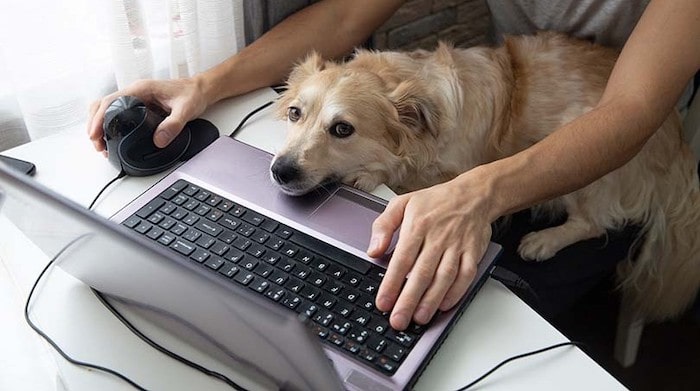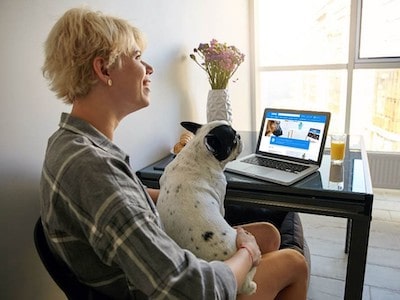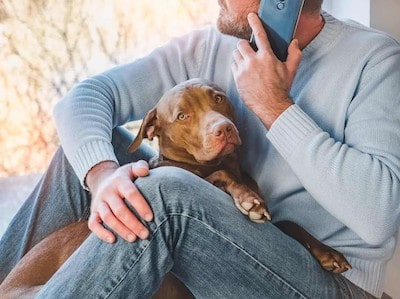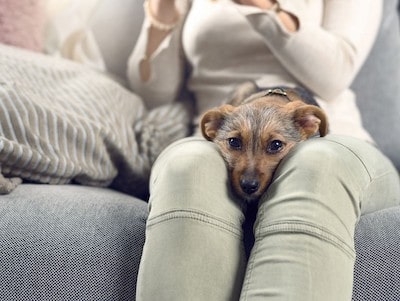Dogs, our beloved four-legged companions, have a way of melting our hearts and bringing us immeasurable joy. One of the endearing behaviors they often exhibit is sitting on our laps.
Whether it’s a tiny Chihuahua or a gentle giant like a Great Dane, dogs of all shapes and sizes seem to have an innate inclination to snuggle up on our laps. But have you ever wondered why they do it? What drives this adorable behavior that leaves us feeling loved and needed?
In this article, we will delve into the fascinating world of dogs and explore the science and psychology behind why they choose our laps as their preferred spot.

We will unravel the underlying reasons that contribute to this behavior, considering both the biological instincts rooted in their ancestry and the emotional connections they form with their human companions.
From the joyous moments of cuddling with a warm, furry friend to the therapeutic benefits that lap-sitting offers, we will uncover the multifaceted aspects of this unique canine behavior.
So, if you’ve ever wondered why your dog loves to settle on your lap, get ready to dive into the captivating world of lapdogs as we unlock the secrets behind their irresistible charm.
Table of Contents
The Possible Reasons Why Dogs Sit on Your Lap
- To show affection and bond with you: One of the most prevalent and advantageous causes for dogs to sit on your lap is this. They only want to let you know how much they adore you, are devoted to you, and appreciate your company. This is particularly true for dogs that have a close bond with their owners, such rescue dogs or dogs that have been with you since they were puppies.
- To seek comfort and security: As previously stated, when dogs are anxious or afraid, they may sit on your lap. They could also act in this manner if they are ill or in discomfort. They may feel safer and more at ease by being around you. You may assist them by giving them a secure and comfortable environment and, if necessary, by consulting a veterinarian.

- To assert dominance or territoriality: The less frequent and more detrimental reason that dogs sit on your lap. Some dogs may sit on your lap to demonstrate their dominance or the fact that they own you. This might indicate your dog is feeling insecure or aggressive, which could result in behavioural issues like jealousy, possessiveness, or biting. This is particularly valid for dogs that have experienced cruelty, neglect, or improper training or socialisation.
- To get attention or rewards: Some dogs may sit on your lap in an effort to obtain your attention or a reward. They could ask you to play with them, feed them, or take them on a stroll, for instance. They could also do this if they notice you are preoccupied with or distracted by your phone or laptop. They’re attempting to gain your attention by sitting on your lap so they can obtain what they want.
- To regulate their body temperature: As mentioned earlier, dogs may sit on your lap when they are feeling too cold or too hot. They may also do this when they are feeling tired or sleepy. By resting on your lap, they can conserve their energy and feel more comfortable.
The Benefits of Lap Sitting for Dogs and Humans
Lap sitting is a natural and common behavior for dogs, especially for small breeds that were bred to be companions or lap dogs. Lap sitting can have many benefits for both dogs and humans, such as:
- It can strengthen the bond between you and your dog. Dogs are social animals that crave physical contact and affection from their owners. By sitting on your lap, they are showing you that they trust you and enjoy being close to you. This can also make you feel loved and appreciated by your furry friend.
- It can provide comfort and security for your dog. Dogs may sit on your lap when they are feeling anxious, stressed, or scared. For example, they may seek your lap during thunderstorms, fireworks, or unfamiliar situations. By being near you, they can feel safer and calmer. You can also comfort them by petting them or talking to them softly.

- It can help regulate their body temperature. Dogs may sit on your lap when they are feeling cold or hot. For example, they may seek your warmth during winter or your coolness during summer. By sharing body heat, they can adjust their temperature and feel more comfortable.
- It can improve your mood and health. Lap sitting can also have positive effects on your mental and physical health. Studies have shown that interacting with dogs can reduce stress, lower blood pressure, boost immunity, and increase happiness. By having a dog on your lap, you can enjoy these benefits and relax.
How to Encourage or Discourage Lap Sitting Behavior
Depending on the reason and the situation, you may want to encourage or discourage your dog from sitting on your lap. Here are some tips on how to do so:
- If you want to encourage lap sitting behavior, you can reward your dog with praise, treats, or toys when they sit on your lap. You can also invite them to sit on your lap by patting it gently or calling their name. You can also make sure that your lap is comfortable and spacious enough for them to fit in.

- If you want to discourage lap sitting behavior, you can gently push your dog off your lap or stand up when they try to sit on your lap. You can also ignore them or redirect their attention to something else when they sit on your lap. You can also train them to obey commands such as “off” or “down” when they sit on your lap.
- If you want to prevent lap sitting behavior altogether, you can provide your dog with alternative places to sit or lie down, such as a bed, a couch, or a crate. You can also limit their access to places where you usually sit, such as a chair, a sofa, or a car seat.
FAQ
Is lap-sitting behavior breed-specific?
Lap-sitting behavior is not exclusive to specific breeds. Dogs of all breeds and sizes may choose to sit on their owners’ laps. However, some breeds are more predisposed to this behavior due to their innate affectionate nature and desire for close physical contact
How can I encourage my dog to sit on my lap?
Encouraging your dog to sit on your lap involves creating a safe and inviting environment. Use positive reinforcement techniques such as treats, praise, and gentle petting to reward your dog for sitting on your lap. Additionally, providing a cozy blanket or cushion on your lap can make it more appealing for your dog to snuggle up.
Can lap-sitting become problematic?
While lap-sitting is generally harmless and enjoyable, it can become problematic if it interferes with your daily activities or if your dog becomes possessive or aggressive while on your lap. If such issues arise, it’s important to seek guidance from a professional dog trainer or behaviorist to address and manage the behavior effectively.
Does lap-sitting behavior change with age?
Lap-sitting behavior can change with age, primarily due to physical limitations or changes in a dog’s size. For example, a large breed puppy may easily fit on your lap, but as they grow into adulthood, they may prefer sitting close to you or leaning against your legs instead. However, the emotional connection and desire for closeness typically remain intact.
Conclusion
The act of a dog sitting on your lap is a heartwarming display of their affection and desire for closeness. Throughout this article, we’ve explored the reasons why dogs choose our laps as their favorite spot and discovered the science and psychology behind this endearing behavior.
From seeking comfort and security to fulfilling their instinctual need for proximity to their pack leader, dogs find solace and connection in sitting on our laps. This behavior transcends breed boundaries and is a testament to the strong bond between humans and their canine companions.
Lap-sitting not only brings joy and warmth to our lives but also offers a range of benefits for both dogs and humans. It fosters emotional well-being, strengthens the bond between pet and owner, and provides a soothing effect that can alleviate stress and anxiety.
However, it’s important to respect each dog’s individual preferences and boundaries. Not all dogs may enjoy sitting on laps, and that’s perfectly okay. Building a strong bond goes beyond lap-sitting and can be nurtured through various other forms of interaction and companionship.
As responsible dog owners, it’s crucial to understand the difference between normal lap-sitting behavior and any potential issues that may arise. Seek professional guidance if lap-sitting becomes problematic or if your dog displays possessiveness or aggression.


